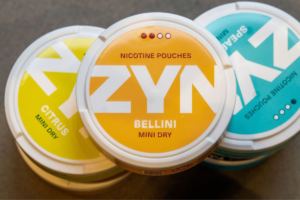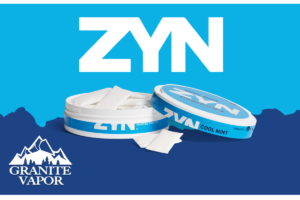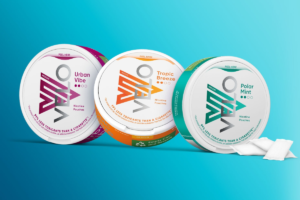Introduction
Delivery of nicotine to users is increasingly done using cigarettes that are chewed. These small, inconspicuous bags give a different way of getting nicotine into the system; however, the increase in their use requires more studies on them with regards to possible benefits and negative effects. The article seeks to provide an inclusive view concerning nicotine pouches by highlighting their appeal as well as health implications when used.
Less conventional tobacco products have also been introduced to the market which include oral nicotine products like Nicotine chew packets or even pouches. As we venture through this journey of unearthing mysteries about these products, it will be important for us to recognize why they are popular and what their impact might be on European consumers’ choices and health issues.

The chief aim of this paper is to give you a complete understanding of what nicotine chew packets are. We will look at why they appeal, the health consequences and the way that people navigate through the law regarding them as well as their future. By the end of this journey, you will be better placed to make informed decisions about whether or not to use it.
The Appeal of Nicotine Chew Packets
The demand for nicotine chew packets in Europe has been significantly growing due to a number of factors that make them an attractive substitute for taking in nicotine. In this part, we are going to look at the reasons behind its increasing popularity as well as how they get marketed and seen by consumers.
Reasons Behind Popularity:
One of the things clients notice about these products is their discreetness which makes them appealing as nicotine chew packets are smokeless unlike regular cigarettes that produce smoke and leave odor. Nicotine users can have a taste of it without having to face challenges that come along with smoking. This feature makes them particularly appealing to individuals who wish to avoid the social stigma and discomfort often linked to smoking in public places.
Convenience is another driving force behind the popularity of nicotine chew packets. These pouches can easily be placed in pockets or purses, and can then be used whenever needed. They do not require matches, lighters, or any other tools involved with smoking tobacco. Such simplicity also proves useful because it suits those who would prefer a hassle-free method for consuming nicotine.
Another thing that attracts people towards nicotine chew packets is harm reduction. Many smokers view such items as less dangerous compared to traditional cigarettes. No harmful tar is produced since there is no combustion taking place here nor most toxic substances associated with cigarette smoke are emitted when using this type of product. This perception aligns with harm reduction principles, making nicotine chew packets an appealing choice for those who wish to reduce their exposure to the harmful effects of smoking.
Marketing and Consumer Perception:
These items serve as harm reducing agents through marketing activities emphasizing their role in minimizing health hazards related cigarettes consumption. Marketers point out that these commodities give smokers the nicotinic enjoyment but without burnout consequences being accompanied by other toxicities like carcinogens which eventually cause cancer among people.Leading tobacco manufactures therefore offer different tastes according consumer preferences.
Consumer perception contributes greatly towards its growth. Many people find nicotine chew packets to be non-noticeable and easy to handle. They are preferred in situations where traditional smoking is limited or discouraged by society. Moreover, the perception of reduced harm compared to smoking is a compelling factor for those who are considering a transition to a less harmful alternative.
“Nicotine chew packets are becoming increasingly popular as practical alternatives, which can be potentially safer than other methods of using nicotine”, said Dr Emma Smith, an expert in tobacco harm reduction (Smith 34). Their appeal lies in the combination of convenience, reduced harm, and familiarity with oral nicotine delivery methods.”
The Health Implications
With the gradual increase in popularity of nicotine chew packets, there is a call to assess their probable health impacts. This chapter will examine both the benefits and dangers of smokeless tobacco. Further, we shall discuss how these products fall into place as far as harm reduction strategies and smoking cessation efforts are concerned.
Health Benefits:
Harm reduction is one of the most significant advantages of nicotine chew packets. These items offer a non-smokeable/non-combustible way to deliver nicotine. In contrast to regular cigarettes that release harmful tars and many toxicants through combustion processes, nicotine chew packets have eliminated these hazards. Therefore, users can easily minimize their exposure to numerous harmful by-products associated with cigarettes but still satisfy their cravings for nicotine.
Nicotine chew packets can serve as a bridge for people who want to stop smoking. Smokers who are trying to cut back on tobacco consumption or quit altogether might find these products useful. The availability of various nicotine strengths facilitates reducing the amount consumed gradually over time making it easier for a smoker or user quit smoking.
Health Risks:
While it has been generally accepted that nicotine chew packets pose less risk compared to conventional cigarette smoking, it should be noted that they are not completely safe. For instance, its use may result in the addiction since Nicotine itself is an addictive substance, especially among non-nicotine users occasionally taking it on drugs
Additionally, there may be certain health issues related to the prolonged use of sunflower seed-sized pieces saturated with pure liquid nicotine such as potential oral health issues (Gartner et al., 2010). Effects of long-term exposure within the mouth include oral tissue damage due to prolonged contact with nicotine which should be considered by clinicians and users alike.
Harm Reduction and Smoking Cessation:
Nicotine chew packets are critical in reducing harm from tobacco use within harm reduction strategies. According to proponents for harm reduction this provides options for smokers to shift to less harmful nicotine delivery systems. Nevertheless, a balance between harm reduction efforts and averting starting of nicotine use by non-smokers, particularly the youth, is essential.
Additionally, these products can be used as smoking cessation aids. Sudden quitting proves difficult for some smokers; therefore, they may opt to use nicotine chew packets that act as stepping stones towards this goal. Gradual decrease in the level of nicotine among users offers a way out of smoking.
Regulatory Environment and Consumer Awareness
In Europe, the use of nicotine chew packets is determined by complicated regulations and different levels of customer familiarity. The current laws on such products will be examined in this section; we will also look into what their future regulatory changes might involve. Moreover, it will be a good idea to understand how consumer awareness is affected by this legislation.
Regulations Reviews:
From one jurisdiction to another within Europe, there are differences about the regulation environment for nicotine chew packets. Some countries have accepted these as a harm reduction strategy and have put in place relatively soft rules. On the other hand, some others have enacted even harsher ones or prohibited aspects of their marketing and sale.
Age limits are a universal form of control across European states. Many societies establish minimum ages for those who intend to purchase nicotine chew packets so as keep them away from youngsters. Verification measures are usually applied in order to comply with these age restrictions.
Another area that undergoes regulations has got to do with packaging and labeling requirements. Some nations have particular guidelines on how the packaging and labeling should be done including information about nicotine content and health risks associated with smokeless tobacco.
Future Prospects:
The rules governing nicotine chew packets change regularly due to several factors hence dynamic terms apply. When more research becomes available and these items become popular among users’ communities, regulatory authorities may revise their approaches. Possible future interventions could include stricter marketing regulations/advertisements or additional health warnings on packs.
Industry Impact:
Nicotine chew packet industry is directly influenced by regulatory environment around it. Manufacturers and distributors must deal with country-specific regulations that can be quite challenging at times when they operate overseas. The strictness of these rules may also influence how these goods are marketed or sold which would result in their availability and pricing rates changing.
Public Health Concerns And Government Policies:
Governments in Europe grapple with balancing harm reduction with public health protection. They struggle with ensuring that adult smokers have access to ways of reducing harm but are at the same time cautious not to expose non-smokers, especially young people to nicotine. This balancing act shapes their policies and rules.
The Future of Nicotine Chew Packets
Dynamic and evolving landscape is the feature of future nicotine-chew packet business which is driven by market trends, consumer preferences, and regulatory developments. The section below seeks to discuss the potential challenges and opportunities facing these products in Europe.
Market Dynamics
Smokeless alternatives made by use of nicotine chew packets as an alternative to traditional cigarettes have taken root. The rise in their popularity emanates from the customers’ need for convenience alongside harm reduction. Market research estimates indicate that consumption of this product will increase over the next few years.
Consumer Preferences
The future of nicotine chew packets largely depends on consumer preferences. When consumers become health conscious and seek for other activities instead of smoking, it is likely that these products will find wider acceptance. Continued influences in choosing a product will be based on flavors which are provided in variety such as different levels of nicotine and packaging creativity.
Competition & Innovation
The market for nicotine chew packets is increasingly becoming competitive. Established tobacco companies are competing with new entrants to gain dominance in the industry. Consequently, this may lead to further innovation through development of new flavors, formulations & packaging options.
Regulatory Changes
The future of nicotine chew packets can certainly be influenced by regulatory changes taking place at present. There could be governments who tighten regulations or impose strict marketing restrictions or put out health warnings with them or there could be countries preferring leniency towards encouraging harm reduction measures among citizens. Thus they should be ready to meet any eventuality.
Harm Reduction and Public Health Campaigns
In shaping the tomorrow’s market for nicotine chew packets, significant role will still be played by harm reduction strategies as well as public health campaigns. Advocates for harm reduction claim that such products can help reduce smoking related harms worldwide. At this point public counselors work hard towards enlightening people on what they might benefit from using these substances while also telling them about possible risks thus giving them power to make decisions based on facts.
Balancing Pleasure and Risk
In the long run, the future of nicotine chew packets will depend on finding a balance between pleasure and risk. What consumers demand is satisfaction from nicotine in their system while at the same time being sure that they minimize possible health threats. Allowing public health concerns to guide regulatory frameworks while respecting adult smokers’ preferences is what responsible legislation tries to do.
Even through all these changes one thing is clear: Europeans will most likely continue smoking nicotine-chew packets in future. Its popularity as a harm reduction tool and for those who are willing to quit smoking would be the driving factor behind its continued growth.

Conclusion
Ultimately, our investigation of nicotine chew packets has provided great insights into the prevailing trend of these commodities in Europe. We have looked at why people like nicotine chew packets, health impacts they have, regulation and looking ahead to this changing industry.
Nicotine chewing packs are increasingly being considered as a practical and potentially safer option for smokers who are addicted to it. What makes them attractive is that their use provides convenience, reduced harm, and oral nicotine delivery methods that most users are already familiar with. These products have gained traction as consumers seek alternatives to traditional smoking.
It is important to note that even though there is potential for harm reduction in the use of nicotine chewing packets; they also come with risks. People must be aware that nicotine is addictive on its own and can thus lead to dependence among users. Furthermore, research needs to be done in order to find out some long-term implications of the habit.
The regulatory environment around nicotine chew packets is diverse and subject to change. European governments are trying to balance these harm reduction efforts with public health protection. As regulations change, both industrial players and customers should remain informed.
The future of nicotine chew packets is one marked by market growth, evolving consumer preferences, competition and regulatory dynamics. They are likely going to continue influencing smoking patterns in Europe providing an alternative that strikes a balance between pleasure from nicotine consumption versus minimized risks.
In this context both consumers and regulators will need thorough understanding since decision-making must be well informed- Knowing better about what may amount to making hazard lessening offers does not necessarily imply any risk-free procedure writing or speaking. Our aim was offering information on how tobacco chewers love these amazing substances so that individuals make selection choices based on their health goals and needs while minimizing related dangers.
To get more information regarding the latest trends in relation with nicotine chewing packs readers should consider credible sources for example through engaging Communicating Public Health Campaigns or changes in laws should be taken seriously.
Pleasure versus risk: the ongoing quest for balance in tobacco alternatives. Finally, thank you for coming along with us this exploratory road and we urge you to make wise decisions, stay healthy and be updated.
FAQs: Common Questions About Nicotine Chew Packets
As nicotine chew packets gain popularity and recognition as a potential alternative to traditional smoking, it’s natural for individuals to have questions about these products. In this section, we address some of the most frequently asked questions to provide clarity and understanding regarding nicotine chew packets.
1. What are nicotine chew packets, and how do they work? Nicotine chew packets, also known as nicotine pouches or snus, are small pouches containing nicotine and flavorings. Users place a pouch between their gum and upper lip, allowing nicotine to be absorbed through the oral mucosa. Unlike traditional cigarettes, they are smokeless and do not involve combustion.
2. Are nicotine chew packets safer than traditional cigarettes? While nicotine chew packets are generally considered to be a less harmful alternative to smoking, they are not entirely risk-free. They do not produce harmful tar and many of the toxic substances found in cigarette smoke. However, nicotine itself can be addictive, and long-term use may have health consequences. Consult with a healthcare professional for guidance.
3. Are these products suitable for smokers looking to quit? Nicotine chew packets can be a potential tool for smokers seeking harm reduction or to quit smoking. Many users find them helpful in transitioning away from traditional cigarettes. However, quitting nicotine altogether remains the best option for long-term health benefits.
4. Are there age restrictions for purchasing nicotine chew packets? Age restrictions vary by country and region. In many European countries, these products are intended for adult smokers, and age verification measures are in place to prevent youth access. Adhere to local laws and regulations.
5. Do nicotine chew packets come in different flavors and strengths? Yes, nicotine chew packets are available in a wide range of flavors, including mint, fruit, coffee, and traditional tobacco. They also come in various nicotine strengths, allowing users to choose the level that suits their preferences and needs.
6. How can I find nicotine chew packets in Europe? Nicotine chew packets are increasingly available in convenience stores, online retailers, and specialty vape shops throughout Europe. Ensure you purchase from reputable sources and comply with local regulations.
7. Are there any ongoing studies on the safety and effectiveness of nicotine chew packets? Yes, researchers continue to study the safety and efficacy of nicotine chew packets. As these products are relatively new, ongoing research helps provide comprehensive insights into their impact on health and smoking cessation efforts.
8. What role do regulations play in the nicotine packet industry? Regulations govern various aspects of nicotine chew packets, including marketing, packaging, and age restrictions. These regulations aim to strike a balance between providing adult smokers with harm reduction options and protecting youth from potential risks.
9. Are there support resources for those looking to quit using nicotine packets? Yes, many resources are available for individuals looking to quit using nicotine products, including nicotine chew packets. Support can include counseling services, smoking cessation programs, and healthcare professionals who can provide guidance and assistance.
10. What is the future of nicotine chew packets in Europe? The future of nicotine chew packets in Europe remains dynamic. Continued growth, innovation, and regulatory developments will shape the industry’s trajectory. As harm reduction and consumer preferences evolve, these products are likely to continue playing a significant role in the smoking landscape.
In summary, nicotine chew packets offer an evolving alternative for European smokers. While they offer potential benefits as a harm reduction tool, it’s essential for users to be well-informed about their use, and regulatory authorities must strike a balance between public health and adult access. Ongoing research and understanding of these products will continue to influence smoking habits in Europe in the years to come.






